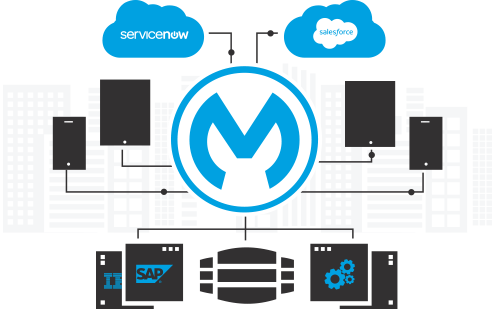- Home
- Resources
- Articles
- Enterprise integration
- Legacy System Integration
Legacy System Integration via Mule ESB
As businesses face growth and expansion, they also face the problem of legacy system integration with new technologies, web applications, mobile applications as well as in the cloud. Legacy systems are old, inflexible technologies put into place to resolve previous business challenges. These systems, because of their long lifespans, tend to be fragile, obsolete, and difficult to integrate with new cloud and web-based services. The established legacy systems remain in use by companies because legacy system replacement is an extensive and expensive process.
One study by Business Technographics shows that 75% of North America and European enterprise IT budgets are spent on operation and maintenance of legacy systems, leaving only 25% of the budget to be applied to new investments. Another study, conducted by Meritalk and the Unisys Center for Innovation in Government, found that nearly half of the US Federal IT budget is exhausted supporting legacy systems.
Maintaining existing legacy systems is not only costly, it endangers business as it prevents further growth and expansion. Being unable to provide users access to the latest technologies makes it difficult to cultivate new business. Replacing a legacy system altogether is also expensive, risky, requires an excessive amount of developer retraining, and does not take into consideration the future needs of a business. No matter which way businesses turn, they seem to be stuck, unable to find an ideal solution for their legacy systems.
Mule as an ESB Provides the Ideal Solution
MuleSoft offers Mule Enterprise Service Bus (ESB), a robust solution for businesses looking to solve the problem of legacy system modernization. Mule as an ESB is the world’s leading integration platform, providing solutions for enterprises looking to unlock the value of legacy systems. With Mule ESB, companies can rapidly address short-term integration challenges on a future-proof foundation that enables long-term success.
Mule ESB, part of Anypoint Platform, offers numerous benefits for its users:
- Faster delivery of legacy modernization projects
- Low-cost, low-risk process
- Graphical legacy data mapping and transformation
- Minimal retraining for existing developers
- No vendor lock-in
- Flexibility for future business needs
Legacy system integration tackles the challenge of connecting APIs both on-premises and over the cloud, bridging the network divide. Integration takes information from on-premises systems and leverages new systems in order to drive business. Mule takes on the challenge of legacy system integration by exposing those legacy systems and providing a gateway for communication between the cloud applications and the legacy systems.
Concerns with Legacy System Integration
Many enterprises are concerned with cloud integration security, as integrations between on-premises and cloud solutions often deal with sensitive data. With Anypoint Enterprise Security, enterprise integrations are protected, unauthorized access blocked, and sensitive information secured. Anypoint Enterprise Security also provides secure access to APIs and SOA endpoints, encrypts data, and implements security filters.
Another concern with legacy system integration is high availability. Because Mule as an ESB is highly scalable, reliable, and available, enterprises can guarantee application uptime. Mule Enterprise clustering is built on an in-memory data grid, allowing instances to run the same applications and share the workload while retaining transient state information. In doing this, Mule provides guaranteed reliability. If any Mule instance undergoes an outage, one of the other instances jumps in to take over immediately, without service interruption.
Mule as an ESB can handle even the most high-performance applications. Mule High Availability supports mission-critical applications, minimizing the risk of downtime, as it can result in extensive loss of business.
Mule ESB Solves the Legacy System Integration Dilemma
Legacy system integration with cloud-based services is generally difficult, but not with Mule as an ESB. With a catalog of cloud connectors, users have instant API connectivity to numerous applications and services, allowing for connection on-premises or in the cloud quickly. Through cloud integration, Mule as an ESB is able to communicate between several components - messaging services, connectors, frameworks, etc. - to streamline processes and ensure interoperability. Mule as an ESB possesses the ability to connect cloud systems together to leverage shared data and maximize the input of the data across the organization.
Mule ESB Makes it Easy
Mule as an ESB permits seamless integration of modern and legacy systems, solving the problem of old infrastructure while preparing enterprises for future integration needs. By employing cloud connectors, businesses have instant API connectivity to popular applications and services, allowing cloud integration as well as on-premises, with just about anything. With its simplified integration process, easy to use graphical design environment (Anypoint Studio), and familiar developer tools, customers can be up and running in minutes. Mule ESB is lightweight and flexible, robust and powerful, able to adapt to any enterprise’s existing infrastructure.

Furthermore, MuleSoft provides the option to use an integration platform as a service (iPaaS) such as CloudHub to take on the challenge of hybrid integration between legacy systems and cloud-based systems. With the proliferation of SaaS applications in the workplace, businesses must find ways to connect on-premises legacy systems with cloud-based systems to remain innovative. In order to maintain the information from the legacy systems and still drive new business, companies have considered hybrid integration as a solution to their legacy system modernization needs.
Learn more about what Mule ESB offers by reading the following case studies:
- PacificComp - Learn how Mule facilitated an entire overhaul for the insurance firm
See what Mule as an ESB can do for your enterprise or contact us to speak with an expert today.



